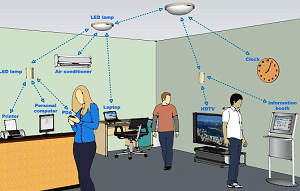Data communications just got a bit more interesting thanks to lasers. Visible light communications abbreviated as VLC – no not the video player – is a technology that utilizes visible light to carry data from one device to the other, unlike radio frequencies that are used today. A new paper on the subject has been published in the ACS Photonics journal. The authors are from the King Abdullah University of Science and Technology (KAUST).
VLC technology makes use of lasers or LEDs which appear as normal lights. The catch is that the lights are turning on and off faster than the human eye can observe. Reportedly, the light sends data in binary code to a receiver that deciphers it. A converter changes the laser light into colors that receive the transmission and decodes into “white light” that then captures the data being sent.

Osman Bakr, one of the researchers on the team developing a VLC color converter, said: “In this work we break the record for data communication using visible light, and more impressively produce white light with a very high color rendering index of 89, by designing a special color converter based on hybrid perovskite nanocrystals. Our work demonstrates white light as both a lighting source and a system for ultra-high-speed data communications.”
The researchers’ color converter allegedly has 40 times the bandwidth for transmission, compared to already available commercial converters. The team was able to reach 2 gigabits per second, trumping data transmission technology like WiFi.
“In this bandwidth-hungry era, there will be a continuous push by consumers for VLC systems with higher bitrates. We believe that white light generated by semiconductor lasers will one day replace the LED white light bulb for energy-efficient lighting. To achieve this objective, we set our long-term goal to develop nanocrystals that can convert high-energy excitation photons from the semiconductor lasers to Red-Yellow-Green-Blue (RYGB) lights at ultra-short photon lifetime,” said Boon Ooi, one of the researchers and inventors behind the new converter.
The future of smart lighting that could produce data connection points which could transmit data to devices could be here sooner than we think. Engineers have been working on Li-Fi technologies that would make this possible. However, visible light communication could replace Li-Fi as a data transmitter in buildings with lighting fixtures, without the need of radio frequencies.
Source: PHYS


